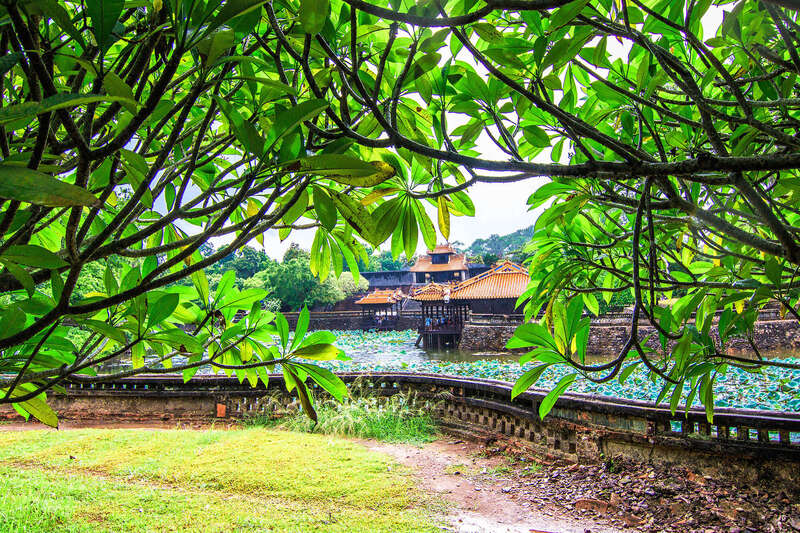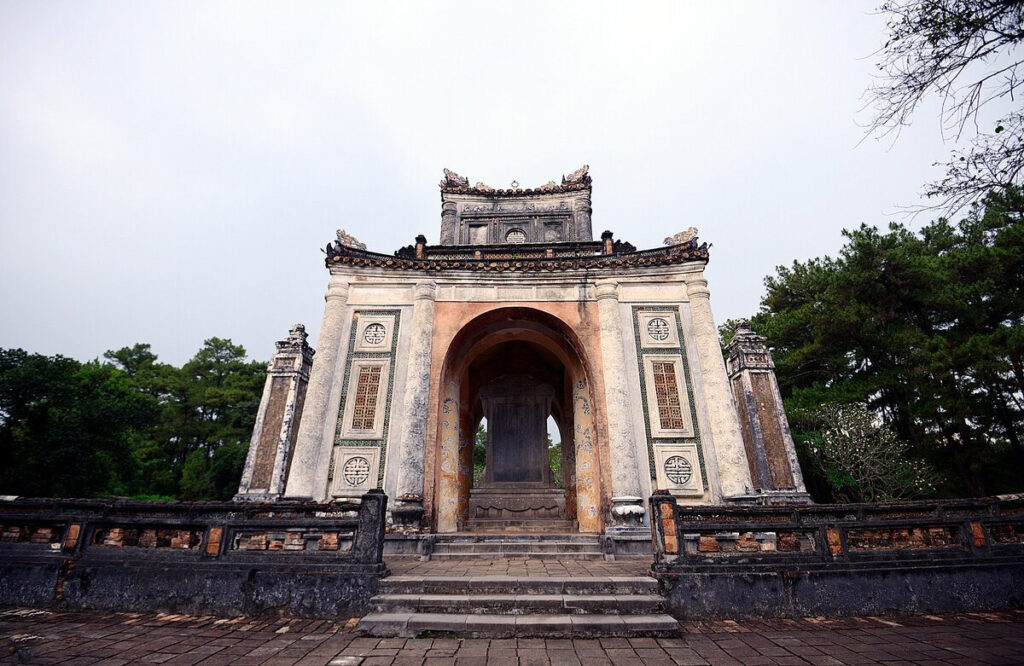Visiting the Tomb of Tu Duc in Hue – A Place of Timeless Beauty and Poetic Charm
The Tomb of Tu Duc is undoubtedly one of the most impressive royal tombs in Hue, Vietnam. Nestled peacefully amidst the lush hills and serene landscapes, this site offers a unique and captivating experience for travelers.
The Tomb of Tu Duc attracts visitors with its remarkable architecture (Photo: Collected) One of the must-visit destinations in Hue is undoubtedly the Tomb of Tu Duc. This tranquil resting place belongs to Emperor Tu Duc, a monarch of the Nguyen Dynasty who possessed the soul of a poet and a romantic heart. Let’s explore the uniqueness of this architectural masterpiece in the following article.

Overview of Tu DucTo mb in Hue
1.1 Address of Tu Duc’s Tomb
Tu Duc’s Tomb is situated on a serene piece of land, to the right of the picturesque Cảnh Vọng Hill, located in Thuy Ba Hamlet, Thuy Bieu Commune, Thuy Xuan Ward, Hue City.
For a perfect visit to Tu Duc’s Tomb, it’s recommended to go between January and February each year. During this time, Hue has passed the rainy season, and the transitional weather is cool and pleasant, ideal for strolling around the tomb’s surrounding scenery.
Tu Duc’s Tomb is conveniently located just about 6 kilometers from the city center of Hue, making it easily accessible. Travelers can opt for a taxi or rent a motorbike in Hue. To reach the tomb, you can follow Bui Thi Xuan Street from the Hue train station, then turn onto Huyen Tran Cong Chua Street, and a short distance later, you will arrive at the tomb area.
1.2 Opening Hours and Ticket Prices for Tu Duc’s Tomb
The opening hours and ticket prices for Tu Duc’s Tomb are undoubtedly of great interest to many visitors. The ticket prices at the entrance are as follows:
- Tickets for tourists: 150,000 VND per person.
The ticket price for Tu Duc’s Tomb is quite affordable, suitable for students and anyone interested in exploring this architectural wonder. The tomb is open from 6:30 AM to 5:00 PM in the summer and from 7:00 AM to 5:00 PM in the winter. With these time frames, visitors can effectively plan their exploration of other Hue tourist attractions.
1.3 When Was Tu Duc’s Tomb Built?
Historical Background of the Tomb’s Formation Known as the most beautiful architectural work during the Nguyen Dynasty, this is the final resting place of Emperor Tu Duc, the longest-reigning emperor among the 13 emperors of the Nguyen Dynasty. Reigning during a difficult period of external threats, family conflicts, and a tumultuous society, Emperor Tu Duc chose to build his tomb as a second palace to escape from the harsh realities of life. So, when was Tu Duc’s Tomb built?
The construction of Emperor Tu Duc’s tomb began in 1864, with the involvement of 50,000 laborers at that time. Initially named Van Nien Co, the tomb was later renamed Khiem Cung. After the emperor’s death, it was renamed Khiem Lang.
To this day, Tu Duc’s Tomb is considered one of the four most beautiful tombs on the Hue tourism map. It is recognized as a UNESCO World Cultural Heritage site and one of Vietnam’s first historical relics featured in the 3D digital museum as part of the Google Arts & Culture project.
- Exploring Tu Duc’s Tomb in Hue
When visiting Hue and hearing about Tu Duc’s tomb, visitors will be amazed by the unique and romantic architectural features of the most beautiful tomb of the Nguyen Dynasty. If you are unsure about what to explore in “Tu Duc’s tomb map,” consider the following three activities not to be missed when visiting this destination.
2.1 Admire the Unique Architecture of Tu Duc’s Tomb
The architecture of Tu Duc’s Tomb is considered the most beautiful among the tombs of the Nguyen emperors. The tomb complex consists of nearly 50 constructions, including the Honor Gateway, Khiem Cung Mon, Luong Khiem Palace, and more. Notably, all the names of these constructions contain the word “Khiem,” which conveys the meaning of humility and modesty, values highly regarded by Confucian scholars of that time.
Khiem Cung Mon Khiem Cung Mon is a two-story building resembling a pavilion, serving as the emperor’s resting place during his visits to the tomb. In the center stands the Hoa Khiem Palace, flanked by Phap Khiem Vu and Le Khiem Vu on either side.
Luong Khiem Palace Located behind the Hoa Khiem Palace, Luong Khiem Palace currently serves as a place of worship for Tu Duc’s mother, Tu Du. To the right of the palace is On Khiem Duong, a place that preserves ancient artifacts.
Minh Khiem Theater On the left of Luong Khiem Palace is the Minh Khiem Theater. This area is where the emperor used to enjoy traditional music and arts. Today, it is considered one of the oldest theaters in Vietnam and a place that bears the cultural imprint of the Nguyen Dynasty.
Tinh Khiem Island Tinh Khiem Island is situated in the middle of Luu Khiem Lake. It offers a picturesque and romantic landscape, surrounded by lush greenery. This area is used for planting flowers and preserving some rare and precious animals.
Additionally, around the island, you can find Xung Khiem Ta and Du Khiem Ta, where the emperor used to compose poetry, read books, and find inspiration.
Tomb Area Leaving the palace area, visitors will enter the tomb area. Moving to Bai Dinh, visitors will have the opportunity to witness two rows of majestic stone statues of mandarins and generals. Right behind them is the Bi Dinh, with a stone slab weighing over 20 tons engraved with Tu Duc’s autobiography, portraying his life’s joys and sorrows.
2.2 Enjoy the Cool and Serene Atmosphere in the Tomb’s
Surroundings The Tu Duc Tomb area is enveloped by a lush green canopy, creating a refreshing and cool ambiance. It not only exudes a sense of solemnity and grandeur but also adds romantic and poetic touches to its beauty. When visiting the tomb, visitors can bask in the fresh and invigorating air amidst the enchanting natural landscapes of Hue.
Furthermore, the Tu Duc Tomb is located adjacent to Vong Canh Hill. This vantage point offers a harmonious blend of trees, mountains, rivers, and lakes, providing travelers with unforgettable moments of relaxation.
2.3 Strike a Pose at the Vintage-Inspired Photo Spots of Tu Duc’s Tomb Hue’s royal tombs, known for their beautiful architecture, are a harmonious blend of Vietnamese tradition and classical French architecture. Therefore, these sites often become famous check-in locations for tourists.
Visitors should choose the quieter hours for the best “live virtual” photos. With the backdrop of historical landmarks, you may want to wear traditional clothing or an áo dài (Vietnamese traditional dress) and a non la (conical hat) to match the surroundings.
Some famous check-in spots to consider include Ky Van Cac Palace, Hoa Khiem Palace, Luu Khiem Lake, and more. It’s essential to follow the regulations to protect the cultural heritage while taking photos.

- Important Notes for Visiting Tu Duc’s Tomb Before visiting Tu Duc’s Tomb, tourists should be aware of the essentials they need to prepare, such as:
Attire: Travelers should choose suitable, modest, and respectful attire that matches the historical significance and architectural colors of the location.
Snacks: Prepare snacks and drinks to stay energized during the visit.
Sun Protection: Sunscreen, hats, sunglasses, and other sun protection items are essential to protect yourself during your journey.
General Cleanliness: Tu Duc’s Tomb is a long-standing historical site, so visitors should be conscious of preserving the landscape and environment.
- Exciting Tourist Spots Near Tu Duc’s Tomb in Hue Around the Tu Duc’s Tomb area, there are many other attractive tourist destinations that draw visitors for exploration. Some notable places to visit include:
Vong Canh Hill: This is a famous tourist destination in Hue. From the top of the hill, you can enjoy breathtaking natural landscapes and admire various architectural structures, including Tu Duc’s Tomb, Thien Mu Pagoda, and more.
Thuy Xuan Village: This eco-tourism village attracts many visitors. It offers numerous homestays and resorts and outdoor activities such as elephant riding, boating, and fishing for travelers to relax and enjoy.
Dong Khanh’s Tomb: This tomb was built to commemorate and preserve the relics of Emperor Dong Khanh, the ninth emperor of the Nguyen Dynasty.
Huong Lam Pagoda: This ancient temple is dedicated to preserving sacred artifacts and scriptures. It features traditional Vietnamese architecture blended with unique Chinese influences.
When promoting Tu Duc’s Tomb to international tourists, it’s essential to emphasize its rich historical and cultural significance, unique architecture, serene atmosphere, and the opportunity for visitors to immerse themselves in the poetic and romantic ambiance of the site.

